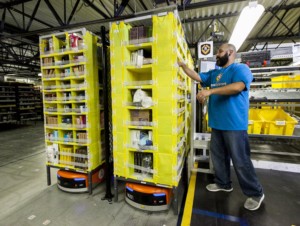 You surely know this little orange robot at Amazon commonly known as Kiva, which powers many Amazon Fulfillment Centers. Turns out, there are more robots in use at Amazon, some for similar tasks, some for something completely different. In this post I would like to give you an overview of all the robots at Amazon (that I know of). There’s at least six different robots in action.
You surely know this little orange robot at Amazon commonly known as Kiva, which powers many Amazon Fulfillment Centers. Turns out, there are more robots in use at Amazon, some for similar tasks, some for something completely different. In this post I would like to give you an overview of all the robots at Amazon (that I know of). There’s at least six different robots in action.
The Original Kiva
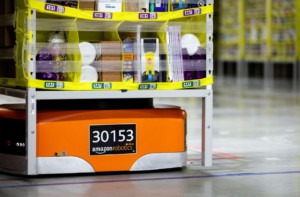 The original Kiva is pretty much the robot that Kiva supplied to Amazon, back then called DU 1000 for a driving unit with 1000 pounds lifting capacity. Most of you still know them as Kivas. Since Amazon bought Kiva Systems in 2012, however, Amazon uses the name Amazon Robotics and avoids the term Kiva – even though everybody knows them by that name.
The original Kiva is pretty much the robot that Kiva supplied to Amazon, back then called DU 1000 for a driving unit with 1000 pounds lifting capacity. Most of you still know them as Kivas. Since Amazon bought Kiva Systems in 2012, however, Amazon uses the name Amazon Robotics and avoids the term Kiva – even though everybody knows them by that name.
This robot moves shelves (called pods) around for faster and cheaper stowing and picking. (See my series on Amazon Fulfillment Centers for more details). It is about 75cm long and 60 cm wide (2.5 by 2 feet), and fits nicely underneath a pod that measures roughly 1x1m. It is 30cm (1 foot) high, weighs around 110kg (250 pounds) and can lift 450kg (1000 pounds). Like most of the robots here, it has a speed of 5 km/h (3 miles per hour), or comfortable walking speed.
The Hercules
The Hercules also dates back to the original Kiva Systems development introduced in 2007. Back then it was called DU 3000 as a driving unit with 3000 pound lifting capacity. It is designed for heavy-duty lifting. The principle is similar to it smaller cousin, but Hercules can lift much more weight. It is larger in all dimensions, and therefore the pods are also larger. There are also pallet-pods, which are pallets on a frame with legs for the robot to go underneath.
The Pegasus
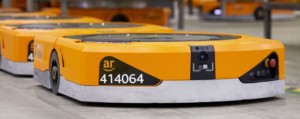 The successor to the original Kiva is named Pegasus after the mythical winged horse. It performs the same function as the original Kiva and moves pods around. However, it is only 19 cm high, 10cm less than the original Kiva. This means 10cm more space to store stuff! It can also lift 560kg, a bit more than the old one with 450kg. And, probably most important, it has only half the parts and is cheaper to buy!
The successor to the original Kiva is named Pegasus after the mythical winged horse. It performs the same function as the original Kiva and moves pods around. However, it is only 19 cm high, 10cm less than the original Kiva. This means 10cm more space to store stuff! It can also lift 560kg, a bit more than the old one with 450kg. And, probably most important, it has only half the parts and is cheaper to buy!
It is unlikely that Amazon will replace all original Kivas, since this would be expensive. However, they may use the Pegasus for new fulfillment centers. Amazon states that they especially want to use it close to city centers. They want more fulfillment centers close to high-population densities to have more deliveries within two hours or even one hour. But being close to a large population means everybody else wants to be there too, and competes for the site, which drives prices up. The Pegasus helps to fit more stuff into a warehouse to reduce investment cost. A few hundred Pegasus robots are already working at Amazon. Below is a video from the manufacturing facility that produces the Pegasus bots.
The Pegasus X-Sort Drive
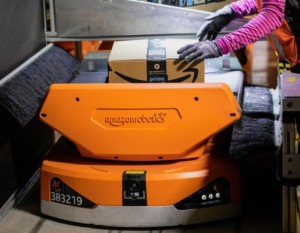 The Pegasus is also intended to be a generic base for different attachments on top. One such an attachment is the X-Sort Drive, basically half a meter of conveyor belt.
The Pegasus is also intended to be a generic base for different attachments on top. One such an attachment is the X-Sort Drive, basically half a meter of conveyor belt.
This robot has a completely different purpose and does not carry pods. Instead, it is used to sort and transport completed parcels to shipping. After labeling (called SLAM), a worker places the parcel on the robot. The robot knows which truck the parcel goes to and moves to the corresponding chute. At the chute the conveyor belt simply throws the parcel into the chute. This can be seen very nicely in the video below.
The concept itself is not new, and I saw videos from China using a similar sorting technology a few years ago. Still, it is a nice implementation. It will help Amazon become more flexible. Rather than the tangled mess of conveyor belts that are used for sorting now, the robots allow for much more flexibility in changing the fulfillment center. According to Amazon it also has halved the mis-sorting errors.
Since this Pegasus involves even more robots moving around, Amazon had to program even more traffic rules and had to create a new job position of “flow control specialist.”
The Xanthus (Coming Soon?)
 The Xanthus is the successor of the Pegasus. I am not sure where the name came from, as Wikipedia lists at least 16 different mythical figures named Xanthus, but it is probably one of the three horses called Xanthus. This robot was first presented at the Amazon MARS conference in June 2019. It is also a drive unit that can carry pods, but it also has the possibility of using numerous different attachments. The Xanthus is much thinner, has one-third the number of parts, and costs half as much as the original Kiva. Since it has less parts, it is also easier to maintain.
The Xanthus is the successor of the Pegasus. I am not sure where the name came from, as Wikipedia lists at least 16 different mythical figures named Xanthus, but it is probably one of the three horses called Xanthus. This robot was first presented at the Amazon MARS conference in June 2019. It is also a drive unit that can carry pods, but it also has the possibility of using numerous different attachments. The Xanthus is much thinner, has one-third the number of parts, and costs half as much as the original Kiva. Since it has less parts, it is also easier to maintain.
The Xanthus has the option of many different attachments, shown in the image below. The base unit is in the center. To the left and right of it are x-drive units, similar to the Pegasus X-Sort drive, used for sorting parcels to different chutes. These are also called Xanthus sort bots.
At the very right is a Xanthus Tote Mover. This can move the yellow boxes (called totes at Amazon). These totes are used to move items from picking to packing, and also if needed to multi-sort and gift wrap (check my previous series on Amazon if you want to know more on these steps). Similar to the sort bots, these can make setting up a new fulfillment center much easier, since you no longer need as many conveyor belts. The Xanthus on the very left is a movable cabinet, which they unfortunately did not go into more detail about. These robots are not yet in use but seem to be in the late stage of development shortly before roll out.
The images above are screenshots from the Amazon Mars Keynote. Below is the video, with the presentation of the Xanthus starting at 2:37.
The Robostow
 Finally, a “normal”-looking robot that stays put where it was installed. The Robostow is a typical articulated robot used to lift pallets or boxes around. These are actually not Amazon core technology but normal third-party robots. The one shown here was made by Thiele and is called “Robostow”; a similar robot in Bad Hersfeld, Germany, was made by ABB and called “Chuckle Berry.” In Bad Hersfeld it was actually the only robot, since it was a manual fulfillment center. You can find these type of robots in many fulfillment centers.
Finally, a “normal”-looking robot that stays put where it was installed. The Robostow is a typical articulated robot used to lift pallets or boxes around. These are actually not Amazon core technology but normal third-party robots. The one shown here was made by Thiele and is called “Robostow”; a similar robot in Bad Hersfeld, Germany, was made by ABB and called “Chuckle Berry.” In Bad Hersfeld it was actually the only robot, since it was a manual fulfillment center. You can find these type of robots in many fulfillment centers.
The Drone (Experimental)
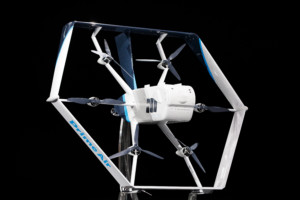 The Amazon drone is intended to bring parcels the last mile from the fulfillment center to the customer. They are currently able to fly up to 15 miles carrying up to 5 pounds and deliver within 30 minutes. These drones can start and land like a helicopter, but fly like a plane for longer distances. It is at the moment just an experiment, and any videos you can find are shot far away from any buildings for safety reasons.
The Amazon drone is intended to bring parcels the last mile from the fulfillment center to the customer. They are currently able to fly up to 15 miles carrying up to 5 pounds and deliver within 30 minutes. These drones can start and land like a helicopter, but fly like a plane for longer distances. It is at the moment just an experiment, and any videos you can find are shot far away from any buildings for safety reasons.
The Amazon Scout (Early Testing)
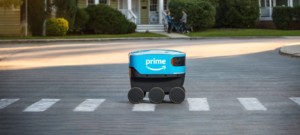 Finally we have the Amazon Scout. Like the drone, this is used to deliver the parcels the last mile from the fulfillment center to the customer. However, if you want to have your parcels delivered by this cute box on wheels, you better live very close to the Amazon headquarters in Seattle, as (at least in the beginning) an employee of Amazon walks along with it for safety reasons. Also, I am not sure how long this box of free goodies and spare parts would survive the more-demanding environment of Detroit. In any case, the neighborhood in the video below surely looks nice.
Finally we have the Amazon Scout. Like the drone, this is used to deliver the parcels the last mile from the fulfillment center to the customer. However, if you want to have your parcels delivered by this cute box on wheels, you better live very close to the Amazon headquarters in Seattle, as (at least in the beginning) an employee of Amazon walks along with it for safety reasons. Also, I am not sure how long this box of free goodies and spare parts would survive the more-demanding environment of Detroit. In any case, the neighborhood in the video below surely looks nice.
So that’s it. To the best of my knowledge, these are all the robots that Amazon either uses or is testing for potential use. Quite an impressive lineup, with surely more to come in the future. Now, go out, think how robots can make your life easier, and organize your industry!

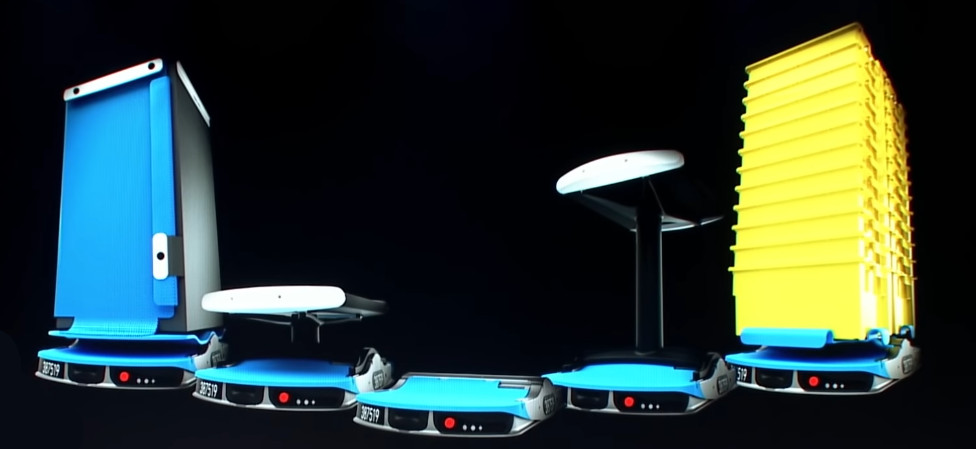
Very interesting article as always ! Thank you for the great work.
Unfortunately, I don’t see any video in this article. Is it coming from my browser ?
Ups, my mistake. Forgot to add the video. Fixed. Thanks for the Heads Up 🙂
Many thanks Mr Christop R. good article to look future, to open mindset, to catch future…
Thanks Dr. Christoph for the informative and valuable article.
Prof Roser, have you seen this article? Business Insider: Amazon will now turn away employees running a fever and dock their pay – Business Insider.
https://www.businessinsider.com/amazon-implements-temperature-checks-employees-1004-degrees-partial-pay-2020-4?r=DE&IR=T
Amazon treats it’s robots better than it’s workers!
Hi Andre, as mentioned in an earlier article on Amazon, I cannot judge the work conditions well. There seems to be also an information war going on with both sides claiming data that supports their view. I believe the truth is somewhere in between, but I don’t have the facts on this.
Hello , I would like to ask if is possible to study that online? I’m working by Amazon and i would like to developing my self , that why I’m here 😊
Thanks with best wishes
Hi Tamer,
You can find some more of my articles on Amazon in the table of content. I have quite a few on the inner workings. I hope they are helpful to you 🙂
Hey, I work at Amazon as a Trainer for the robotics division and I want to let you know that most of the information in this article is incorrect. Pegasus is a sort attachment for the Hercules drive. They are all Hercules drives and the lifter capability is nowhere near 3,000 pounds. A lot of the other information is also correct, but I shouldn’t disclose that information.
good job
in re Andre’s comments about Amazon’s treatment of workers.
First, this has nothing to do with the original article.
MOST of us probably visited this site to read and discuss LEAN, TPS, IR4.0+, SCRUM, AGILE, etc not about political extremism.
There are opinions about amazon that I would suggest derive largely from
1 political extremists of BOTH sides
2 failed associates who are terminated, yet who refuse to take personal responsibility
3 jumping on the bandwagon
4 individual low level supervisors rather than actual corporate policy
As an Amazon associate who has worked in an actual fulfillment warehouse, I would absolutely agree that there areas where there ARE areas where Amazon can improve. But Andre’s post was during the height of the covid pandemic.
Measures were put in place to PROTECT other associates AND protect customers.
Yes, associates were turned away IF they ran fevers. But even tier one associates get a relatively generous sick PAID TIME OFF even from DAY ONE. Active covid testing was implemented FREE OF CHARGE at every warehouse. Employees could opt out, but IF they opted out, they were expected to wear a mask (provided FREE of charge). At the time, associates testing positive either at work or through third parties were given an ADDITIONAL three PAID days off AND virtually unlimited free unpaid time off. Additionally, speed metrics were pretty much ignored during this time. Virtually no one got “written up” for low productivity during that time.
I believe that Amazon’s response to covid was more than fair.
I certainly believe that Amazon CAN improve some of their actual associate satisfaction perception points! But I would suggest that Andre’s perception of Amazon is more an issue of LOW LEVEL SUPERVISION issue, or even a building level management issue, than it is a corporate issue.
Congratulations,
Thank you great article,
There are other examples of robotics that have been used and there are more third party suppliers than you listed. But I am simply amazed that your article which is about 40 months old is MORE UP TO DATE than recent articles in the mainstream media and even in Business and Investing websites!
For context, my post is 40 months past the original post and there has been a huge investor interest in AI that is probably only a temporary “FOMO” fad rather than the continuous growth that AI and ML really is
And yes, in the part 40 months we have moved on and we have made improvements and new acquisitions, not just for purposes of hardware, but also for Intellectual Property.
And I’d like to point out that our AI and ML is acquiring data with every transaction both coming and going and within!
I came across this site because I read some really ridiculous articles within the past few weeks, even from very respected sites, and I thought, “We’ve had this for at least ten years, we’ve already moved on.”
Keep up the great work
I just subscribed and am looking forward to more articles like this on Lean, Agile, SCRUM, IR4.0+